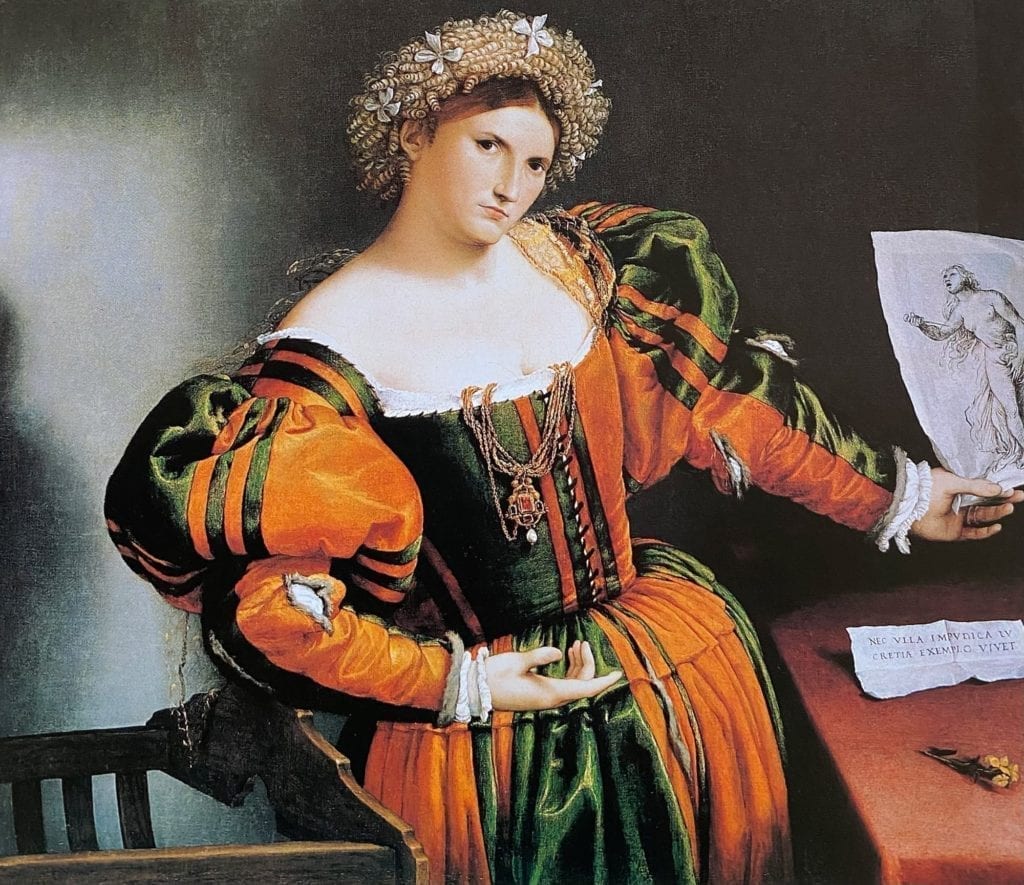Lorenzo Lotto painting Lady With a Drawing of Lucretia is more than a portrait. It revels in story. This bold lady in an ornate dress calls back to the tale of Lucretia. In Livy’s History of Rome, Lucretia was raped. She then killed herself as a statement that she was not responsible for the shame it brought upon her. We see the direct strength of this act in the face of Lotto’s woman here. She’s got nothing to be ashamed of and she knows it.
Click below for an audio version of this piece:
Many art historians believe Lorenzo Lotto painted a different Lucretia here as well. Namesake of the Latin Lucretia, this Lady With a Drawing was an Italian noblewoman. We can tell this from her elegant puffy-sleeved dress. She’s got the goods with a golden chain draped at the breast. But this lady doesn’t want us to focus on these fancy bits. Lotto has fixed her gaze upon us. She seems to demand we meet her eyes. With this focal point and the humble bouquet of tiny flowers, he signals chastity. The woman in Lady With a Drawing of Lucretia seems innocent. Spoiled by neither her namesake or riches – she’s bold and true.
Trapped Lady With a Drawing of Lucretia
But boldness doesn’t set us free from our boundaries. Lucretia reminds us of this too. This Lady With a Drawing‘s stiff in posture. Even her outstretched arm juts in a rigid point to the sad inscription about her namesake. The background Lotto painted also shows her penned into a tiny space. She’s crammed between an unyielding wooden chair and the table. There’s no luxury in the setting, only in her self. This noble Lucretia seems certain. At the same time, she’s bound by her surroundings.
This refers back to the Latin Lucretia. She too was strong in herself. It was all she had, this certainty. Virtue mattered more than all else at that time. Unfortunately, so did the judgements of others – right or not. The Lucretia of yore found herself trapped in a prison of public opinion. So captive, in fact, that Lucretia believed her only way out was death.
We know the Lucretia of this painting will leave her tight enclosure. This momentary prison is only temporary. But what of the true trap in her life? She relates to this former Lucretia. So, this woman too lies subject to public opinion. Her noblewoman status means many expectations. She must impress. The elaborate dress isn’t enough, after all. Jewelry and a ruffled halo adorns her as well. Lotto gives us hope with this Lucretia, though. He composed her with a resolute expression and stern glare. It shows she’s determined to overcome gossip and slander. This Lucretia will live strong and true to herself.
Lorenzo Lotto – Factoids
- Lorenzo Lotto (1480 – 1556) was an Italian painter of the 1500s.
- Born in Venice, he also studied in the Venetian school.
- Lotto did only portraits and religious paintings.
- In fact, his most famous work Polyptych of Saint Domenico is a glorious religious devotional.
- Though he started out in Venice, Lotto soon left for easier Italian cities. Only after he established himself as an artist did he return to Venice.
- Even as an established talent, Lotto always struggled financially.
- Art historian Bernard Berenson reinvigorated interest in Lotto in the late 1800s.
ENJOYED THIS Lady With a Drawing of Lucretia ANALYSIS?
Check out these other essays on Italian painters.
